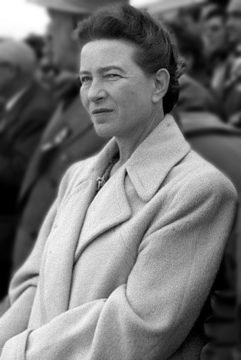Toril Moi at The Point:
 One evening in 1932, Simone de Beauvoir joined Jean-Paul Sartre and his old schoolfriend, the philosopher Raymond Aron, for a drink at a bar in Montparnasse. The three of them enthusiastically ordered apricot cocktails, the specialty of the house. Aron, who had just returned to Paris from a year studying philosophy in Berlin, suddenly pointed to his glass and said: “If you are a phenomenologist, you can talk about this cocktail and make philosophy out of it!” According to Beauvoir, Sartre “turned pale with emotion.” This was exactly what he wanted to do: “describe objects just as he saw and touched them, and to make philosophy out of it.”
One evening in 1932, Simone de Beauvoir joined Jean-Paul Sartre and his old schoolfriend, the philosopher Raymond Aron, for a drink at a bar in Montparnasse. The three of them enthusiastically ordered apricot cocktails, the specialty of the house. Aron, who had just returned to Paris from a year studying philosophy in Berlin, suddenly pointed to his glass and said: “If you are a phenomenologist, you can talk about this cocktail and make philosophy out of it!” According to Beauvoir, Sartre “turned pale with emotion.” This was exactly what he wanted to do: “describe objects just as he saw and touched them, and to make philosophy out of it.”
Phenomenology—the tradition of philosophy after Husserl and Heidegger—sets aside questions of essence and ontology and tries instead to grasp phenomena as a particular subject experiences them. A philosophy concerned with perception and experience would allow Sartre to shrink the gap between literature and philosophy and write philosophical texts filled with scintillating, though sometimes sexist, descriptions, anecdotes and stories: a cafe waiter playing at being a waiter, a woman who has gone to a cafe for a first date, a man flooded with shame when he is caught peeping through a keyhole in a hotel corridor.
more here.
